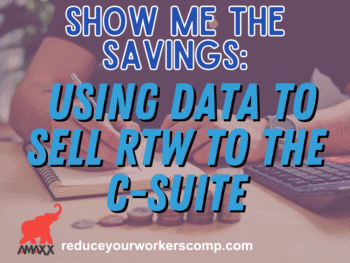
The Importance of Dignity and Respect
In union environments, dignity and respect are critical components of the work culture. Many unions were formed as a result of workers feeling mistreated, disregarded, or unprotected. Therefore, the union’s role is often rooted in advocating for the rights, safety, and well-being of their members. It is essential for employers to recognize and respect this foundation when engaging with unionized workers, especially in the return to work process.
This post is one in a 3-part series:
The concept of dignity and respect often forms the basis of successful negotiations. When workers feel that their rights and concerns are genuinely being considered, they are more likely to cooperate with the return-to-work process. This trust-building approach can lead to smoother negotiations and better outcomes for all parties involved. When approaching a unionized environment, keep the following in mind:
- Understand Why Unions Are Formed: Unions exist to protect the interests of workers, ensure fair treatment, and foster a sense of community. By understanding the motivations behind unionization, employers can approach discussions with a sense of empathy and purpose.
- Emphasize Respect and Trust: Union members expect to be treated with dignity and respect. Employers should ensure that their actions align with these values by being transparent, addressing concerns, and fostering open communication.
Click Link to Access Free PDF Download
“13 Research Studies to Prove Value of Return-to-Work Program & Gain Stakeholder Buy-In”
The Role of Collective Bargaining Agreements
Collective bargaining agreements (CBAs) often define the rules and expectations around many employment issues, including return-to-work policies. In a unionized environment, the CBA acts as the guiding document that determines what can and cannot be done when it comes to modified duties or accommodations. Understanding these agreements is crucial for avoiding conflicts and ensuring a smooth return to work process.
Most CBAs contain provisions that describe the rights of management to run the company effectively, but the specifics of return-to-work arrangements may not always be directly addressed. This can lead to misunderstandings or inconsistencies in implementation. When engaging with unionized workers, employers should:
- Review the CBA Thoroughly: Understand the management rights as outlined in the CBA. It’s important to know what is allowed under the agreement and where there might be opportunities for negotiation.
- Be Prepared for Negotiation: If the CBA does not explicitly address return to work, be ready to negotiate with the union. Engaging union representatives early and discussing how return to work can benefit both the employee and the organization is crucial.
- Prioritize Health and Safety: Safety concerns are often the underlying reason for certain restrictions in CBAs. For instance, unions may resist placing an employee in a different role for fear of safety risks. Address these concerns directly by discussing retraining opportunities, modified duties, or ways to ensure that the work environment remains safe for everyone.
Strategies for Enhancing Collaboration
Successfully implementing an return to work program in a unionized environment requires collaboration, open communication, and a willingness to find mutually beneficial solutions. Here are some key strategies to enhance collaboration between employers and union representatives:
- Financial Impact Transparency: Unions often have a welfare fund to provide benefits for injured workers. Extended absences can place a financial burden on this fund. By sharing data and showing how getting employees back to work in a safe and supported manner can help sustain the welfare fund, employers can make a strong case for collaboration.
- Regular Meetings and Open Communication: Maintain open communication between union leaders, management, and employees. Invite union representatives to participate in discussions about return to work processes, share data, and seek input from all stakeholders.
- Emphasize Skill Retention and Retraining: For many union members, the opportunity to retain and improve their skills is highly valued. Employers can frame return to work as a chance for skill retention or even an opportunity for cross-training. This helps to foster a culture where returning to work is seen as beneficial rather than a burden.
- Use Safety as Common Ground: In both union and non-union environments, safety is a top priority. By emphasizing that all efforts to bring employees back to work are done with safety as the primary concern, employers can build trust and reassure union representatives that worker welfare is at the forefront of decision-making.
Understanding the Us vs. Them Mentality
A common challenge in union environments is the “us vs. them” mentality. This often stems from a history of adversarial relationships between labor and management. Union leaders may feel pressure to maintain a firm stance to show solidarity with their members. Understanding this dynamic is crucial for employers who wish to successfully engage with unions.
- Acknowledge the Union Leader’s Role: Union leaders have a responsibility to protect their members, and part of that role often involves challenging management to secure the best possible outcomes for their members. Acknowledging this role and working with, rather than against, the union leaders can help in fostering a more cooperative environment.
- Foster a Spirit of Partnership: Rather than viewing the union as an adversary, approach the relationship as a partnership. Both sides ultimately want to achieve the same goal—ensuring that employees are treated fairly, and that they have safe and sustainable employment opportunities.
FREE DOWNLOAD: “13 Research Studies to Prove Value of Return-to-Work Program & Gain Stakeholder Buy-In”
Conclusion
Navigating the return-to-work process in union and non-union environments requires an understanding of the unique dynamics at play. By prioritizing dignity and respect, thoroughly understanding the collective bargaining agreement, and fostering collaboration, employers can create a return-to-work program that benefits both the employee and the organization. Open communication, transparency, and a shared focus on safety can help bridge the gap between labor and management, making the return-to-work process smoother and more effective.
Ultimately, a successful return to work program in a unionized setting depends on building trust, respecting the foundational values of the union, and finding common ground to ensure that both employee well-being and organizational needs are met. By implementing these strategies, employers can overcome challenges and create a more harmonious and productive return-to-work environment.

Contact: mstack@reduceyourworkerscomp.com.
Workers’ Comp Roundup Blog: http://blog.reduceyourworkerscomp.com/
Injury Management Results (IMR) Software: https://imrsoftware.com/
©2024 Amaxx LLC. All rights reserved under International Copyright Law.
Do not use this information without independent verification. All state laws vary. You should consult with your insurance broker, attorney, or qualified professional.

















